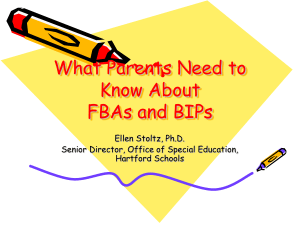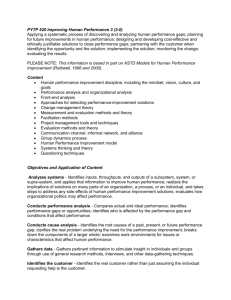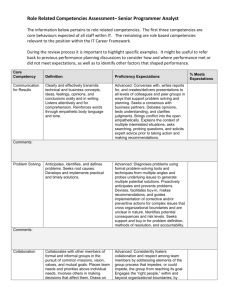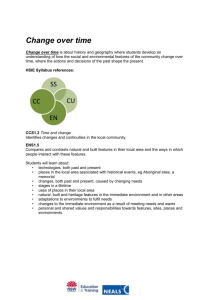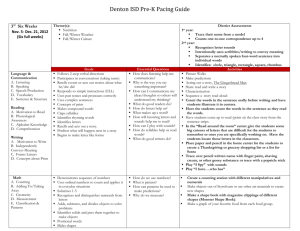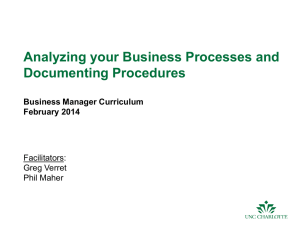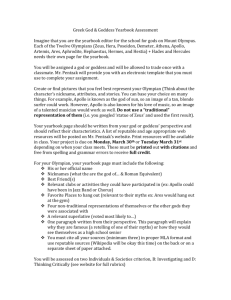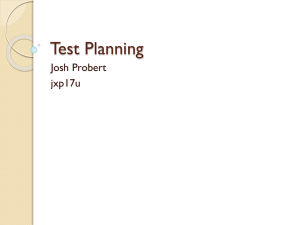Families in our communities
advertisement
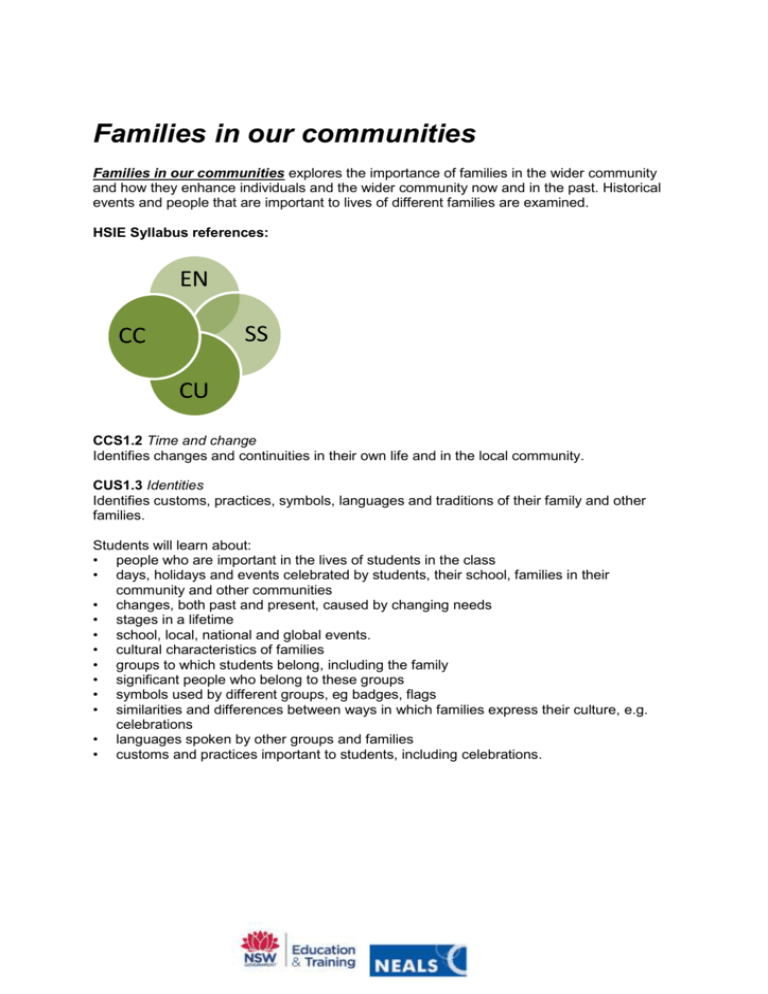
Families in our communities Families in our communities explores the importance of families in the wider community and how they enhance individuals and the wider community now and in the past. Historical events and people that are important to lives of different families are examined. HSIE Syllabus references: EN SS CC CU CCS1.2 Time and change Identifies changes and continuities in their own life and in the local community. CUS1.3 Identities Identifies customs, practices, symbols, languages and traditions of their family and other families. Students will learn about: • people who are important in the lives of students in the class • days, holidays and events celebrated by students, their school, families in their community and other communities • changes, both past and present, caused by changing needs • stages in a lifetime • school, local, national and global events. • cultural characteristics of families • groups to which students belong, including the family • significant people who belong to these groups • symbols used by different groups, eg badges, flags • similarities and differences between ways in which families express their culture, e.g. celebrations • languages spoken by other groups and families • customs and practices important to students, including celebrations. Teaching and learning Evidence of achievement Introducing our families Select a suitable story book to use with the class that portrays a family and referrs to what is important to the family and how they support each other. • Initiate a class discussion on different families. Begin with the family portrayed in the story book and then have students respond with examples representative of different families. Discuss: - what makes up a family? - what activities do the family on the story enjoy? Discuss why these activities are important to the family in the story. Ask students to identify some activities their own families participate in. Develop a list that includes social, sporting and cultural activities. Students explain why these activities are important in their own families. Students record and display this information. - select one family member from the story book. What sort of person do you think they are? Use the photos for ideas and list describing words (adjectives) on a word bank. Are they happy, kind, friendly? Identify some of the characteristics of own family members and record. - Utilise some images of families that show different generations and changes over time. Use photos that show people at different ages and stages of their life. Discuss the ages and stages shown. How is this reflected in the student’s own (extended) family? - how are families different? Generalise the discussion to encompass a wide range of families. - how do families help family members and other people? - what are some of the different roles that members might play in a family? CUS1.3 Identifies customs, practices, symbols, languages and traditions of their family and other families • identifies and talks about the lives of people in their family and community • identifies characteristics that make another family different or similar to their own. • Introduce the concept of an artefact. With reference to the story book (or introduce another story) What sort of artefacts would a character in the story consider to be precious e.g. a medal. What sort of things would they collect to represent who they are? What would be precious? What would make them laugh or cry? What would remind them of long ago? What would represent their family and the culture of their family? List some items. Students will need one family portrait style photograph of their family members for this and subsequent lessons. Display these photos for reference. Students may represent their family in a drawing if a photo is not available. • Select a story book examines what is of value to the character(s) in the story. Ask questions to facilitate students’ understanding of things they value, such as: - what things or objects do you have that are special to you? How are they special? - who gave it to you? - how do you treat the objects that you treasure? - do we all value the same things? Why/why not? - what special things do you like to do with your family? CCS1.2 Identifies changes and continuities in their own life and in the local community • describes people at different stages of their life • talks about the lives of people from different cultures. Teaching and learning Evidence of achievement Different identities • Create a display of photos and images of people, or use the photographic broadsheets included in the Treasures teaching kit. Ensure the photos or images illustrate modern and historic contexts, children, male and female subjects and representations from a range of cultural groups. Suitable images can be sourced from the Picture Australia web site. • Initiate a class discussion using the images. Ask: - who is in the picture? How do you know? - are they male or female? - do they remind you of anyone you know? Why? - what is happening in the photo? Does your family do things like this? - what other things can you tell from the photo? - why do you think these photos were taken? • Continue to ask questions to enhance students’ understanding of the visual information contained in the photos and images. CUS1.2 Identifies changes and continuities in their own life and in the local community • describes people at different stages of their lives • talks about the lives of people from different cultures. Photographs are valuable because they are a record of events, places and people. Personal photographs are records of individuals: the details of their life, the people they have known, the groups they’ve belonged to, their likes and interests. Additional questions are available on pp. 20–21 of the Treasures teacher book. Greetings • Display images of people greeting each other. Include images from different cultures. • Display images and lead a discussion about greetings: what they are? what is their place in society as a cultural ritual? e.g. shaking hands was to show that there was nothing in your sword hand. Greetings convey respect for the person you are greeting and help to establish positive relationships with people. • Discussion points: - why and when are greetings used e.g. at formal and informal occasions - how do people greet each other e.g. verbal/non verbal greetings such as a hug, kiss, handshake, bow, rub noses or combinations. A cultural example: In Japan, bowing is used when meeting others, saying goodbye or thanking others. The degree of bow is related to the degree of respect for the other person, from a nod of the head to a full bow. Shaking hands is not a tradition in Japan but is used in special circumstances, such as greeting a politician or a prominent person or when being introduced to a foreigner. A bow is the preferred greeting. - how greetings differ between different people e.g. teacher, principal, your parents, your aunt, uncles, grandparents, friends - how greetings differ in different situations e.g. in the CUS1.3 Identifies customs, practices, symbols, languages and traditions of their family and other families • identifies and uses greetings from own family and community • communicates an understanding of how people in another country express their culture through greetings. Teaching and learning street, at a party, the local shopping centre, a wedding, at a church or temple - how greetings vary between age groups e.g. adults and children. • In pairs, or small groups, students role play: - how they greet someone in the morning - how they greet someone in the evening - how they greet their parents and grandparents. - how people in another (specific) culture greet each other formally and informally. • Record a list of different ways people say ‘Hello’ to each other around the world. • Students select an artefact received from a cultural event to talk about. This lesson has been adapted from Lesson plan 5 ‘Greetings are among the rituals shared by different communities. What is a greeting?’ p. 26 Treasures (DET) and Topic 1: ‘Greetings and gestures and images’ pp. 7–10 Where the sun rises (DET) Evidence of achievement Teaching and learning Evidence of achievement My family’s identity Refer to Topic 1, p. 21, Caring for Place – caring for Country (DET) using Gami’s place and My mob from the Big mob books for little fullas (BOS). Both books are about the same extended family. Note that both stories use Gumbayniggirr language and also have accompanying tapes. • Introduce the stories to students one at time. For each story discuss features such as the title, cover illustrations and author. Ask students to predict what they think the story will be about. Identify what is the same and different in each story e.g. the use of pictures compared to photos, Gumbayniggirr words are inside English sentences in Gami’s place, and have been translated in My mob. Both stories are told from a child’s point of view about their family (the same family). • Identify some of the family members in each of the stories; both stories are about members of the same extended family - parents, grandparents, aunties, uncles and cousins, refer to information about the Muurraby Language Centre in Gami’s place and background information included on the tape of My mob. • Discuss what the term ‘mob’ means to Aboriginal people e.g. family or language group. Who is included in a ‘mob’ of extended family members? • Create a word bank of words about family, include words from other languages that students are familiar with and Gumbayniggirr words, where possible also include words from local Aboriginal language(s) e.g. grandmother, Gami, Granny, Nan, Nana, Nona. • Assessment: Discuss: Are all families the same? how are they the same, what do they do that is the same, how are they different, what do they do that is different? • Jointly construct a class chart to show how families are different and how they are the same, include specific aspects of language, traditions, members, customs, practices, family celebrations etc. CCS1.2 Identifies changes and continuities in their own life and in the local community • identifies the family life of others in the local community and in other communities in Australia. Similarities Differences • Students reference the information in the ‘Similarities and differences’ class chart to construct their own illustrated (drawings and magazine cut outs) mind map, with labels to show features of their family’s identity and how their family is similar and different to others. • Students explain how their family is similar and different to other families with reference to their mind map. Students discuss the language(s) of family members, family traditions, culture and celebrations for their own family e.g. birthdays, anniversaries. • Students select an artefact that is representative of their family. Students can explain the reasons for selecting the artefact. CUS1.3 Identifies customs, practices, symbols, languages and traditions of their family and other families • identifies languages spoken in the school and other communities • participates in activities that involve using a different language • participates in activities that involve the communication of cultural symbols, practices and customs • identifies characteristics that make another family different or similar to their own. Teaching and learning Evidence of achievement Assessment strategy The teacher: • analyses students’ illustrated mind maps to show features of their family’s identity and how their family is similar and different to others • discusses mind map with student. Assessment criteria The student: • describes features of their family • identifies language(s) of family members • identifies some important traditions and aspects of their family culture, including language(s) spoken • communicates aspects of family customs • selects and illustrates some special family celebrations • explains some similarities and differences between families. Symbols of our identity • Look at the school badge or school emblem. What does it show? How is this symbol representative of our school community now and in the past? What is the purpose of the school badge/emblem? • Does the school have a school song? - what do the words say? - what do they mean? - how do you feel when you hear the school song? - how do you think students who have left the school feel when they hear the school song? - what is the purpose of the school song? - if necessary learn the words to the school song. • What sporting houses does the school have? - what are their names? - what is the significance of these names? - what symbols/emblems/mascots are used by the sports houses? - how do students feel about the house they belong to? • ‘Advance Australia fair’. When a representative of a country wins international competition, and at the beginning of a national sporting event, the national anthem of the country is played. Australia’s national anthem is ‘Advance Australia fair’. • Read and discuss the meaning of ‘Advance Australia fair’. How does the national anthem represent all Australians? • Learn the words of the national anthem, including the second verse. CUS1.3 Identifies customs, practices, symbols, languages and traditions of their family and other families • participates in activities that involve the communication of cultural symbols, practices and customs. Groups we belong to • Jointly develop a simple retrieval chart of groups that students belong to. Ask students to suggest how to categorise the list e.g. interests, hobbies, age groups, clubs, sports and record on the retrieval chart. Include, where applicable, the following information: CUS1.3 Identifies customs, practices, symbols, languages and traditions of their family and other families. • identifies and describes the groups that individuals belong to including family, class, school and Area of interest Name of group/team Purpose Uniform Colours Reason(s) for joining Teaching and learning Evidence of achievement /club Sport Red Rovers community groups. to play soccer black shorts + red T-shirt Red and black I like to play soccer • Review the chart and have a class discussion based around the following questions: - why do people belong to groups? - do students belong to similar groups? - how can groups help people? - what groups do you belong to at school? (reading groups, band, choir) - what symbols represent different groups? e.g. uniforms, logos, colours - how do you get along with others with others in groups? e.g. share, listen, take turns - do you communicate differently in different groups? e.g. in a playground game compared to reading groups • Ask students to design a symbol for a group to which they belong. This may be a group at school or outside school. Special events • Communities have a variety of special events that people participate in. These could be street parades, fairs or fetes, festivals (often multicultural), gala days, race meetings, shows, market days, opening of a new park, shopping centre, etc. Identify special events that are part of the local community. Discuss the importance of these events: who goes, what happens, what people wear, celebration foods available, music played, etc. • Use some images or artefacts of different events, e.g. show ribbon, banner, hats, flower/fruit/produce items used to promote the special event. • Place images and artefacts on display for students to see. • Create a class list of events that students participate in or celebrate. • Each student writes a statement about an event they celebrate and illustrates something they particularly enjoyed, explaining why. CCS1.2 Identifies changes and continuities in their own life and in the local community • identifies and describes special communities and their significance • compares how things were, the way they are now and how they would like them to be.
